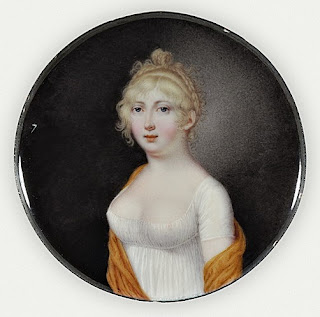 |
| Anonymous German Artist Young Woman in Empire Dress ca. 1800-1810 enamel miniature Musée du Louvre |
 |
| Pietro de Rossi Young Woman in Empire Dress ca. 1800 enamel miniature Musée du Louvre |
 |
| Jean-Baptiste Jacques Augustin Self Portrait ca. 1805 watercolor and gouache on ivory Musée du Louvre |
 |
| Jean-Baptiste Jacques Augustin Portrait of salonnière Juliette Récamier 1801 watercolor and gouache on ivory Musée du Louvre |
 |
| Pauline Augustin Portrait of Hortense de Beauharnais ca. 1810 watercolor and gouache on ivory Musée du Louvre |
 |
| Jean-Urbain Guérin Portrait of Hortense de Beauharnais ca. 1810 watercolor on ivory Musée du Louvre |
 |
| Abraham Constantin Portrait of Eugène de Beauharnais ca. 1810 enamel miniature Musée du Louvre |
 |
| Jacob Conrad Bodemer Portrait of Gustav IV Adolf of Sweden 1803 enamel miniature Musée du Louvre |
 |
| Jean-Baptiste Isabey Portrait of Princess Pauline Bonaparte Borghese ca. 1802 watercolor and gouache on ivory Musée du Louvre |
 |
| Jean-Baptiste Isabey Portrait of Caroline Bonaparte Murat ca. 1805-1810 watercolor and gouache on ivory Musée du Louvre |
 |
| Anthelme-François Lagrenée Portrait of a Young Woman ca. 1800 watercolor on ivory Musée du Louvre |
 |
| Marie Victoire Jacquotot after Élisabeth Vigée-Lebrun Portrait of Marie Antoinette 1818 porcelain plaque Musée du Louvre |
 |
| Marie Victoire Jacquotot Portrait of Mademoiselle de La Vallière ca. 1820 watercolor on ivory Musée du Louvre |
 |
| Marie Victoire Jacquotot after Élisabeth Vigée-Lebrun Portrait of Catherine the Great 1827 porcelain plaque Musée du Louvre |
 |
| Jean-Urbain Guérin Portrait of a Woman ca. 1820 watercolor on ivory Musée du Louvre |
"Now, I ask what the imitation that is limited to the senses in the choice of its subjects and in its mode of representing them, I ask what are its useful effects, what its images can teach me, restricted as they are to the gratification of the eye. I ask what they show me that I do not already know; what they put me in a condition to perceive over and above their model, what impressions depending on art they communicate to me; in short, what acquisition such kind of imitation can promise me or give me reason to hope for."
"I shall be told that it gives me what nature, whose portraiture it is, gives me. I answer, no. It does not give it, precisely because it is only a portrait, and because a portrait is only a part of the resemblance of the natural object, and presents only a single aspect; because such an image, thus limited, and which cannot carry my imagination beyond the confines of reality, gives only the finite, instead of the infinite, to which the soul aspires."
– Antoine Chrysostome Quatremère de Quincy, On the End of Imitation in the Fine Arts (1823), translated by J.C. Kent (1837)